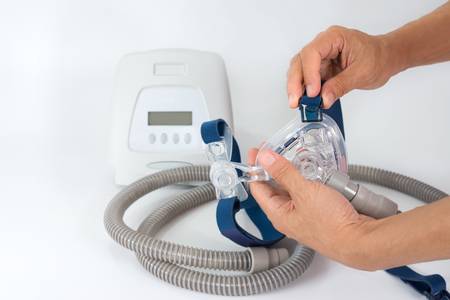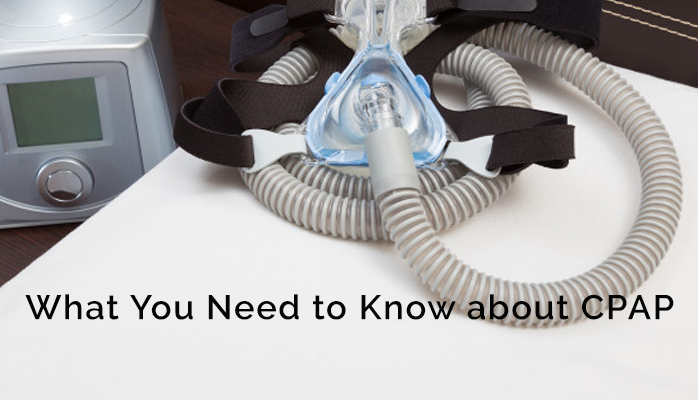Be Comfortable With CPAP
CPAP is often scary for people who are concerned they have obstructive sleep apnea (or have already been diagnosed with it). After all, it doesn’t exactly look comfortable. People who already use it sometimes struggle with ensuring that their CPAP is effective.
If you are concerned about how to use your CPAP and maintain it, then continue reading the article where we will discuss: What a CPAP is
- What CPAP therapy is used for
- How to keep your CPAP effective
- How to maintain your CPAP
- Additional CPAP Tips
What is a CPAP Machine
CPAP stands for Continuous Positive Airway Pressure. A CPAP machine is a small, rectangular box that provides continuous air pressure to keep people with obstructive sleep apnea from lapses in breathing.
CPAP machines provide pressure via a motorized fan inside the device. The small fan is the heart of the CPAP device because it delivers gentle, positive pressure through a connected hose to the breathing mask. The result, no more lapses of breathing at night because the positive air pressure keeps your airway open. The pressure can be a little strange at first, but it’s rare that people report any long-term problems associated with it.
The flexible tube that leads from the fan to a breathing mask is lightweight and kept warm in order to reduce condensation. Among other things, too much condensation can lead to sanitation problems like mold growth.
 This is what a CPAP machine looks like, with the device, flex-tubing, and mask
This is what a CPAP machine looks like, with the device, flex-tubing, and mask
Finally, CPAP machines often are accompanied by a humidification chamber that humidifies CPAP airflow. We recommend always getting CPAP machines with the humidification chamber unless you have a specific reason not to, as the humidification chamber helps keep your nose and mouth from drying out.
It is the primary tool used in CPAP therapy and is considered the gold standard for treating obstructive sleep apnea (OSA). It’s common for people to say “CPAP changed my life.”
Benefits of CPAP
The reason CPAP therapy is so popular is because it is:
- Extremely effective
- Not intrusive
- Portable
- Long term solution
- Not terribly expensive
- Usually covered by insurance
Additionally, CPAP therapy makes dramatic differences in OSA sufferers’ lives by allowing them to live sleep-deprivation free.
What Is Obstructive Sleep Apnea (OSA)
Obstructive sleep apnea occurs when your upper airway becomes blocked while sleeping
OSA happens because the breathing muscles in the back of your throat relax, causing the back of your throat to collapse fully or partially. Once collapsed, your airway can be blocked by the back of your throat, your tonsils, or your tongue. You will then not breathe for a period of time and have to rouse yourself to wake up. Each blockage, cessation in breathing, and arousal cycle is called an apnea, or apnea event.
You will not remember rousing in the morning, and this can happen dozens to hundreds of times per night.
Some of the most common symptoms of obstructive sleep apnea are:
- Loud snoring
- Restless sleep
- Morning headaches
- Severe daytime sleepiness
- Chronic irritability
The main concern with OSA is that it causes sleep deprivation, which leads to shorter life expectancy, lower quality of life, medical conditions, and lower performance in many areas of life
CPAP is the primary way to treat OSA.
Best Practices for Taking Care of your CPAP Machine
Taking care of your CPAP machine is critical for it to perform well and last a long time. In other words, if you don’t take care of it you won’t get the most out of it. Here are best practices for taking care of your machine:
- Wash your CPAP mask daily – you can start by following the manufacturer’s instructions
- Wash your humidification chamber each day, using either warm water and soap or a vinegar solution
- Clean the tubing at least once a weak with warm water and a mild detergent using a CPAP brush
- Wash the nasal pillow of your mask at least several times per week and let it dry completely
Keeping Your CPAP Effective – What to Do
There are several things you can do to ensure that your CPAP machine is working optimally:
- Make sure that the seal over your airways is tight enough for pressure to form
- Buy a type of CPAP mask that feels comfortable and is functional, there are several variations
- Buy a CPAP with a humidifier, as it will help keep your mouth/nose from drying out at night
- If it’s within your budget, get a CPAP that has a built in heater, which will make the air comfortable and help prevent mold from growing
- Take proper care of your machine!
Tips for Using CPAP
Some tips for using a CPAP are:
- Get a travel CPAP machine to use on long flight, while traveling, when camping, etc.
- Get multiple types of CPAP masks to avoid some common issues (such as skin irritation) in using the same type of mask
- Ensure your CPAP has a humidifier, as it will prevent dry mouth and nose
- Make sure your mask it a good fit by trying multiple types and sizes of mask
- Practice wearing your CPAP machine while you are awake to get used to it
- Get a newer model of CPAP, as they are virtually silent
If you live in Alaska, and are concerned that you or a loved one has sleep apnea or has already been diagnosed, please take this online sleep test and get in contact with one of our sleep health professionals.


